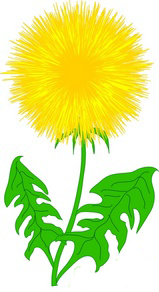Random Sampling with Dandelions


Field biologist often must determine the population size of a species in an area, such as the number of fish in a lake or the number of oak trees in a forest. Such endeavors are not always easy, especially when the area to be studied is large.
PRELAB:
1. Data gathered are often ESTIMATES, as biologist accept that they can never know and exact number for a population. Why would an exact number be so difficult to obtain?
![]() 2. A certain bird of prey will only next in areas that have large oak trees. As part of a reintroduction project, an environmental agency needs to determine if Shawnee National Forest in Southern Illinois has enough oak trees to support the birds. How would you determine this number?
2. A certain bird of prey will only next in areas that have large oak trees. As part of a reintroduction project, an environmental agency needs to determine if Shawnee National Forest in Southern Illinois has enough oak trees to support the birds. How would you determine this number?
![]() 3. Prairie dogs have been spotted throughout Northern Illinois in the tallgrass prairies. These animals live in underground burrows, hunt small game and avoid large birds of prey by running underground. The tall grasses of the prairie can make them difficult to spot. How would you determine the population size of the prairie dog in northern Illinois?
3. Prairie dogs have been spotted throughout Northern Illinois in the tallgrass prairies. These animals live in underground burrows, hunt small game and avoid large birds of prey by running underground. The tall grasses of the prairie can make them difficult to spot. How would you determine the population size of the prairie dog in northern Illinois?
![]() 4. Fish biologists must strike a balance between allowing for recreatinal fishing and maintaining a healthy fish population. How would you determine the number of fish in Lake Rend?
4. Fish biologists must strike a balance between allowing for recreatinal fishing and maintaining a healthy fish population. How would you determine the number of fish in Lake Rend?
5. A maintenance worker at your school is disgusted with the number of dandelions on the field. The principal says that there's really not that many and that it's not a big deal. How can you find out how many dandelions are growing on the field?
ACTIVITY
Purpose: Given an area, field or other space, use random sampling to estimate the population size of dandelions (Taraxacum officinale).
Equipment: 12 meters of string, spikes or similar to mark angles, meter stick or tape measure, area map.
Procedure: Using the meter stick (or tape measure), string and spikes, mark an area 3 meters by 3 meters. Count the dandelions in the area, be sure to count even the ones that have not blossomed.
Compile the data with other plots from other groups, to gather the number of dandelions in a 9m2 area. Find the average population density for the plants . Use the data table below to record the numbers from different groups. (You may need to add to the table if you have more than 8 groups.)
| Quadrant | 1 | 2 | 3 | 4 | 5 | 6 | 7 | 8 |
Number of Dandelions |
||||||||
Average # for all quadrants: |
||||||||
Size of area being studied (use maps or estimate): |
||||||||
Total number of dandelions in the area: |
||||||||
Calculate the populations density of dandelions per m2 |
||||||||
ANALYSIS
Describe two factors that would result in errors with your estimate. What could be changed to improve the accuracy?


